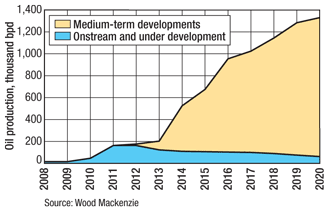DEEPWATER
STATISTICAL REPORT
Brazil’s Santos Basin: An emerging giant
Reserve estimates in 2007 for Brazil’s Tupi discovery established the Santos Basin as an industry hot spot. With the opening of the subsalt frontier, in conjunction with more conventional prospects, the key question now is just how much potential the Santos has.
The Santos Basin could become one of the world’s fastest-growing oil and gas provinces over the next few decades, forecasting an increase in potential future oil production in the discovered fields from 4,000 bpd in 2008 up to 675,000 bpd in 2015, and possibly reaching 1.3 million bpd in 2020.
The sheer size of investment that should pour into the play is awesome—no company involved in the offshore can afford to ignore this basin. However, the investment required by Petrobras and its partners in new infrastructure will be immense and comparable with the opening of the deepwater GOM 30 years ago.
Over the next 10 or 20 years Petrobras will lead the way in transforming the Santos Basin’s minimal infrastructure into an intricate network of production platforms, storage facilities, pipelines and, possibly, some extremely sophisticated gas facilities (such as floating LNG and floating GTL).
The challenge is immense because of the basin’s sheer size and the massive production volumes that are projected.
In May 2009, Petrobras began production from Tupi Field, with one well initially being brought onstream on a test basis. The importance of this test is not about the commercial production of oil and gas, but the collection of data on reservoir performance. At this early stage, the geological uncertainties cannot be overestimated. Test data will be crucial in shaping not only Petrobras’ development concept for Tupi, but for the entire subsalt play.
The current economic and global financial downturn poses a challenge to project development, including financing issues and the slowdown in demand, all of which is compounded by Brazil’s desire to maximize local content. However, even with potential delays, the Santos Basin should be the engine that makes Brazil a global economic powerhouse within the coming decades.
|



